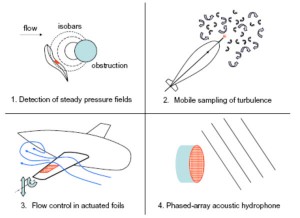MEMS Pressure-sensor Arrays for Passive Underwater Navigation
A novel sensing technology for unmanned undersea vehicles (UUVs) is under development. The project is inspired by the lateral line sensory organ in fish, which enables some species to form three-dimensional maps of their surroundings [1] [2]. The canal subsystem of the organ can be described as an array of pressure-sensors [3]. Interpreting the spatial pressure gradients allows fish to perform a variety of actions, from tracking prey [4] to recognizing nearby objects [2]. It also aids schooling [5]. Similarly, by measuring pressure variations on a vehicle surface, an engineered dense pressure-sensor array allows the identification and location of obstacles for navigation (Figure 1). We are demonstrating proof-of-concept by fabricating such MEMS pressure sensors by using KOH etching techniques on SOI wafers to construct strain-gauge diaphragms.
The system consists of arrays of hundreds of pressure-sensors spaced about 2 mm apart on etched silicon and Pyrex wafers. The sensors are arranged over a surface in various configurations (Figure 2). The target pressure resolution for a sensor is 1 Pa, which corresponds to the noiseless disturbance created by the presence of a 0.1-m radius cylinder in a flow of 0.5 m/s at a distance of 1.5 m. A key feature of a sensor is the flexible diaphragm, which is a thin (20-μm) layer of silicon attached at the edges to a silicon cavity. The strain on the diaphragm due to pressure differences across the diaphragm is measured. At this stage, the individual MEMS pressure sensors are being constructed and tested.
In parallel to the construction of a sensor array, techniques are being developed to interpret the signals from a dense pressure array by detecting and characterizing wake structures such as vortices and building a library of pressure distributions corresponding to basic flow obstructions. In order to develop these algorithms, experiments are being performed on coarse arrays of commercial pressure-sensors.
References
- J.C. Montgomery, S. Coombs, and C.F. Baker, “The mechanosensory lateral line system of the hypogean form of Astyanax fasciatus,” Environmental Biology of Fishes, vol. 62, pp. 87-96, 2001. [↩]
- C. von Campenhausen, I. Riess, and R. Weissert, “Detection of stationary objects by the blind cave fish Anoptichthys jordani (Characidae),” Journal of Computational Physiology A, vol. 143, pp. 369-374, 1981. [↩] [↩]
- S. Coombs, “Smart skins: Information processing by lateral line flow sensors,” Autonomous Robots, vol. 11, pp. 255-261, 2001. [↩]
- [4] K. Pohlmann, J. Atema, and T. Breithaupt, “The importance of the lateral line in nocturnal predation of piscivorous catfish,” Journal of Experimental Biology, vol. 207, pp. 2971-2978, 2004. [↩]
- T.J. Pitcher, B.L. Partridge, and C. S. Wardle, “A blind fish can school,” Science, vol. 194, pp. 963-965, 1976. [↩]

